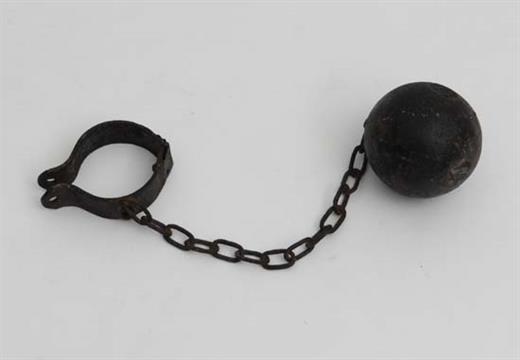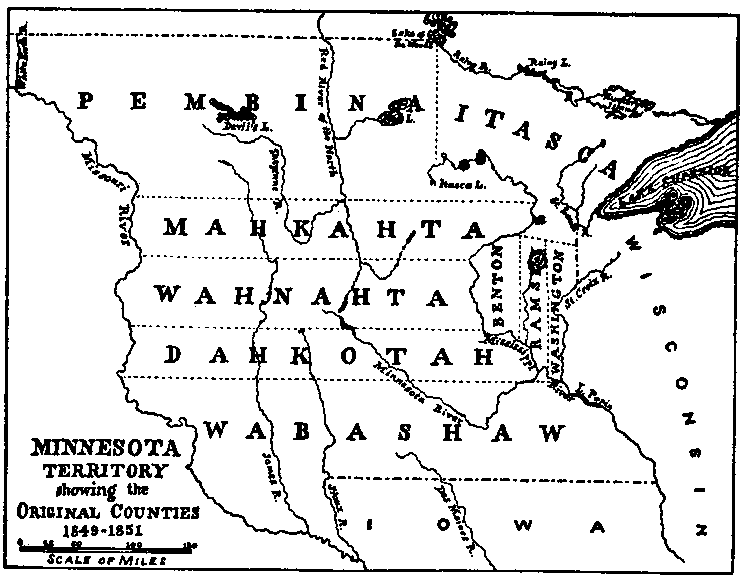This issue: Contents
Tuesday, May 17, 2016
- Editor’s Note
- WCHS News: Washington County Barn Quilt Trail – This Sunday
- WCHS News: Eder School Schedule
- What Is This Thing?!
- Old News: Jail Break!
- Featured Article: Minnesota’s First County
As I sit here typing, I can hear the birds chirping and the sun shining…I think I can finally believe that summer has arrived!
And it certainly arrived with in full-force at the Warden’s House. Over the past week and a half, we’ve had almost 250 students from local elementary schools like Withrow, Rutherford, and Afton-Lakeland explore and experience the museum! It’s always an absolute blast hosting the end-of-the-school-year visits. (Not to mention hilarious because every kid can tell you exactly how many days are left until summer vacation!)
We also hosted our first program of the season this past Sunday when Rick Shefchik brought tales from the early days of Rock N’ Roll to the Warden’s House! So a huge thank you goes out to everyone who attended and helped make our inaugural program a success!
The program series continues right along this coming Sunday with Hay Lake’s first program! Check out our First News story to read how you can learn all about Washington County’s Barn Quilt Trail.
In fact, we here at WCHS love programming so much, that we couldn’t help but pick up another venue in the off-season. Scroll down to our Second News story to read about what will be going on at the historic Eder School this summer!
I hope you’re still enjoying the “What Is This Thing?!” challenges – because I’ve got a real doozy for today’s issue.
Be sure to read today’s Old News to learn about an Old Stillwater Prison inmate’s daring and acrobatic attempt to grant himself a pardon.
And finally, before we close out today, we’ll learn a bit about Minnesota’s First County. (Pst. It’s Washington County. Sorry for the spoiler.)
Oh! And don’t forget, our Annual Beer Tasting is just around the corner! On Saturday, June 18th, beer connoisseurs from across the state will descend upon the Hay Lake Museum – make sure you’re one of them!
Sean Pallas
Historical Messenger editor and Warden’s House Site Manager
spallas.wchs@gmail.com
WCHS News
Washington County Barn Quilt Trail – This Sunday
Join the Washington County Historical Society this Sunday, May 22nd at 2:00 PM at the Hay Lake School to learn about how Olivia Nienaber is using the “Barn Quilt Trail” project to bring together art, history, & health in a unique and fun way. She will also be discussing the upcoming installation of our county’s second quilt trail!
The Washington County Barn Quilt Trail is a 16.4 mile route that winds through the scenic communities of Scandia, Marine on St. Croix, and the Town of May in Minnesota. Along the way, there are seven barn quilts that are based on quilt patterns in the book “The Quiltmaker’s Gift”.
The trail goes through farm areas, a state park, a downtown area, historical sites, and forested areas. The Hay Lake Museum’s barn quilt can be seen alongside the Johannes Erickson Log Home!
Wherever a person is on the Barn Quilt Trail, it’s beautiful.
This is a free program and will be held at the Hay Lake School Museum located one mile south of Scandia, at 14020 195th St N, Marine-on-St. Croix, MN 55047.
Other Events
WCHS News
Eder School Schedule
In case you missed the news – the the programming and operations of the historic Eder School House in Oakdale is now under the growing WCHS umbrella.
Starting June 5th, the School will be open for curious visitors every Sunday, from Noon – 4:00 PM through August 14th (except for July 3rd). Bring the kids over and let them see a classroom without a single smart board or tablet!
But one of the best things about the Eder School is that it shares a parking lot with the absolutely wonderful Oakdale Discovery Center. The Discovery Center has rotating art exhibits, a large aquarium, a “hands-on” wildlife exhibit, and sits in the middle of the 220 acre Oakdale Nature Preserve. The Preserve boasts miles of paved trails, a 28 acre lake, playgrounds, and countless opportunities to enjoy the natural prairie landscape.
So pull out your calendars now and pick a Sunday to make a day-trip to the Eder School and Oakdale Nature Preserve! It’s easy to miss the gems in your own backyard – don’t let this one slip by for another summer!
Eder School Programming:
Sunday, June 5th @ Noon – 4:00 PM: Spinning Wheel Demonstrations – Get a taste of how much effort and labor went into a putting a shirt on your back in the “good old days” with a live spinning wheel demonstration!
Sunday, July 10th @ 2:00 PM: History of Wreslting in Minnesota – Learn about Minnesota’s long history with professional wrestling with Oakdale’s own George Schire, author of “Minnesota’s Golden Age of Wrestling”.
Thursday, July 21st @ 5:00 – 7:00 PM: “Girl from Birch Creek” Screening – Justice Rosalie Wahl, longtime resident of Lake Elmo and the first woman appointed ot the Minnesota Supreme Court Justice, fights for equal justice regardless of race, gender, or economic status in “Girl from Birch Creek“. The evening will begin with an open house of the Eder School at 5:00 and the screening of the documentary will begin at 6:00 PM inside the Oakdale Discovery Center.
Saturday, August 20th @ 2:00 PM: “One-Room Schoolhouses” with Dustyn Dubuque – Learn about Washington County’s one-room school house legacy with Hay Lake School Museum Manager, Dustyn Dubuque.
What is This Thing?!

What Is This Thing?! (Round 35)
Once again, efforts to identify last week’s What Is This Thing?! were made a bit more difficult just by pushing the camera in for a close up! I don’t know about you – but I am loving this little twist to our “mystery challenge” game. (And at 35 rounds in, I think it was due for a bit of innovation anyways!)
Several folks saw the item as some kind of gong or dinner bell, and I can certainly see where that idea would come from! But, if you look really close at the photo, in the bottom left of the image you’ll see a portion of the rest of the artifact which is a bit of a clue.
And of course, if I had pulled back about a foot and used this image…it would be pretty obvious what the item is!
Yes indeedy, last issue’s item was the reflector lens of a kerosene lamp! When you light a candle it naturally sends light in every direction – which isn’t particularly useful when you’re trying to light a room and half of the light is sailing straight into a wall. This reflector lens would help solve that issue by pushing more illumination in the direction of your choosing.
As always, thanks for all your guesses!
Onto today’s challenge! And once again, you’re treated to a close-up photo of a larger object. Although this time, I’ll try to give you a few clues. First, you’ll see a quarter in the picture to help you judge the item’s size and scale. And secondly, whatever this item is; you’d also need one of these in order to use it.
…Of course, I took the second photo really up-close as well. I don’t want to make it too easy on you!
Can you identify the WCHS artifact photographed above? If you’d care to venture an answer, you can send an email to me at spallas.wchs@gmail.com, tweet @WCHSMN, or post your guess on our Facebook page.
Good luck!
Full Image
Old News
Jail Break!
One of the most common questions I get at the Warden’s House is, “Did anyone ever escape the prison?” And the answer is: Absolutely!
Instead of paying for a full stone wall, the territorial government believed a wooden fence would be sufficient to maintain security. However, when this theory utterly failed when it was put to the test. During the tenure of the first warden Francis Delano, over the course of a single night – every prisoner in the territorial prison escaped.
But that was in the 1850s, when guards were only used during the day and only a half-dozen or so inmates were housed inside the prison. What about when the facility was run much more professionally some 40 years later?
Well, let the Stillwater Messenger introduce you to Fred Douglass.
Stillwater Messenger – May 17, 1890
 During the past twelve months a convict whose professional name is Fred Douglass, sentenced in 1889 to fifteen years’ imprisonment for trying to rob a Minneapolis bank, has been giving lessons in how to get out of prison without waiting for a pardon or expiration of sentence. Once he secreted himself in a box car and eluded the vigilance of the guards, but he was discovered as he was getting out of the car and was brought back.
During the past twelve months a convict whose professional name is Fred Douglass, sentenced in 1889 to fifteen years’ imprisonment for trying to rob a Minneapolis bank, has been giving lessons in how to get out of prison without waiting for a pardon or expiration of sentence. Once he secreted himself in a box car and eluded the vigilance of the guards, but he was discovered as he was getting out of the car and was brought back.
At 1:10 Monday Douglass again turned up missing. He was last seen by the officials at 1 p.m. that day, and is supposed that between that and 1:10 he arranged himself in clothes left in or near the foundry by citizen employees of the thresher company, and squeezed through a seven-inch aperture between the top of the gate and the stone arch and escaped unharmed. Nothing has since been heard of him. Hereafter any clothing left around the shops or yard by citizens will be destroyed.
Fred was returned to the prison less than a week later and was forced to wear a ball and chain for his escapades. But this wouldn’t be the last time Fred made a break for freedom – less than a year later, a reported for the Messenger happened to be walking along the road when Fred and two other inmates bolted from the front gate. The reporter was then witness to the escape artist dodging bullets and secreting himself underneath a train for several minutes before being shot at once again – and finally surrendering.
Featured Article
Minnesota’s First County
By Robert and Nancy Goodman
Washington County was created by an act of the Minnesota Territorial Legislature dated October 27, 1849 and signed into law by the new territorial governor, Alexander Ramsey, on November 1. Unlike the other eight counties created that day, Washington County hardly noticed its new status – its officers simply noted the change of name from St. Croix to Washington and continued on doing business as they had for the past nine years.
 Washington was truly the first county in the Minnesota Territory. It was the only surviving political entity from Wisconsin Territory, having become a county in January 1840. When Wisconsin became a state in March of 1848, all of what is now eastern Minnesota was contained in two huge counties that straddled the St. Croix River: St. Croix County, Wisconsin Territory extended from Lake Pepin to just north of Mille Lacs Lake and had its county seat at Stillwater and LaPointe County, Wisconsin Territory, which continued on north to the Canadian border, with its county seat at LaPointe on Madeleine Island.
Washington was truly the first county in the Minnesota Territory. It was the only surviving political entity from Wisconsin Territory, having become a county in January 1840. When Wisconsin became a state in March of 1848, all of what is now eastern Minnesota was contained in two huge counties that straddled the St. Croix River: St. Croix County, Wisconsin Territory extended from Lake Pepin to just north of Mille Lacs Lake and had its county seat at Stillwater and LaPointe County, Wisconsin Territory, which continued on north to the Canadian border, with its county seat at LaPointe on Madeleine Island.
Because the state of Wisconsin was created with its western border at the St. Croix River, the leftover part of these two immense counties (the land between the Mississippi and the St. Croix) was left without government nor territorial officers. Western “Minnesota” (between the Missouri and Mississippi Rivers) was in a similar circumstance. It had been in Clayton County, Iowa Territory, and was also left without political organization when Iowa entered the Union in 1846. But unlike the St. Croix-Mississippi triangle, western Minnesota and most of LaPointe County were still “Indian” territory and not open to white settlement, so few people minded the lack of government.
In St. Croix County the situation was very different in this regard.
In 1838, as soon as treaties with the Dakota and Ojibwe had ceded the lands east of the Mississippi to the United States, settlers had poured in, taking up home sites, building sawmills, and starting towns. In 1848 they saw themselves as disenfranchised.
How many people were living here then? In the debates concerning the forming of the Minnesota Territory, Senator Stephen Douglass of Illinois assured his colleagues that there were “somewhere between eight and ten thousand people” living in the Minnesota region. This was somewhat optimistic – in reality there were only a few thousand Euro-American settlers in the area. The census taken by John Morgan of 1849 painstakingly counted all the non-Native peoples – whites, mixed-bloods, and voyageurs. St. Paul had then 910 people, Stillwater 609, Little Canada 322, and St. Anthony 248. – a little over 2,000 in total. The 1850 census taken the following summer enumerated only about 3,500 people in what had been St. Croix County.
Although in the summer of 1848, there had been considerable discussion about whether Wisconsin Territory continued to exist, the county officers apparently thought it must, as they continued on without break as St. Croix County, Wisconsin Territory. Issuing license, collecting taxes, holding elections and making appointment to offices left vacant when the incumbent was found to be living on the “State of Wisconsin” side of the St. Croix. For the first time in American history, a State and Territory not only shared the same name – but shared borders as well.
The confusing and potentially awkward situation was resolved when Minnesota Territory finally came into being on March 3, 1849, the county government simply kept going without missing a beat as St. Croix County, Minnesota Territory. It was not until the new Minnesota territorial legislature met in the fall of 1849, that the new county of Washington, named for the first President as befitted the first county, was formed.
Minnesota’s first governor, Alexander Ramsey, arrived in the Territory at Stillwater, at 9 p.m., on May 26, 1849. In one of his first official acts declared St. Croix County to be one of three judicial districts, and a regular court was held in Stillwater before the first meeting of the legislature. After consulting with several local officials, the governor proclaimed the first legislative districts and set the election for August 1. Though Ramsey’s proclamation was issued on July 7, District Judge David Cooper had noted in a letter written from Stillwater weeks before that the “quarrel between the aspirants for the legislature (was) waging wondrous hot.”
The election sent three Councilors from the area to the legislature: James Norris of Cottage Grove, David B. Loomis from Marine-on-St. Croix, and Samuel Burkleo from Stillwater. In the lower house there were three representatives from Stillwater – Morton Wilkinson, Sylvanus Trask, and Mahlon Black along with Joseph Furber of Cottage Grove.
 The original bill establishing the first counties in the new territory emerged from Burkleo’s committee on local government with the name of St. Croix county retained – the boundaries being, of course, much reduced. The name was amended to Washington, together with changes to the names of proposed counties of St. Paul, Elk and Koshkonong. The county bill, as passed on October 27, 1849, divided Minnesota Territory into nine counties: Washington, Ramsey, Benton, Itasca, Wabasaw, Dakotah, Wahnahta, Mahkata, and Pembina. Only the first three were declared to be organized counties; the others were “organized only for the purpose of the appointment of justices of the peace, constables, and such other…offices that may be specially provided for.”
The original bill establishing the first counties in the new territory emerged from Burkleo’s committee on local government with the name of St. Croix county retained – the boundaries being, of course, much reduced. The name was amended to Washington, together with changes to the names of proposed counties of St. Paul, Elk and Koshkonong. The county bill, as passed on October 27, 1849, divided Minnesota Territory into nine counties: Washington, Ramsey, Benton, Itasca, Wabasaw, Dakotah, Wahnahta, Mahkata, and Pembina. Only the first three were declared to be organized counties; the others were “organized only for the purpose of the appointment of justices of the peace, constables, and such other…offices that may be specially provided for.”
Governor Ramsey appointed the first officers of the new counties of Benton and Ramsey, but Washington kept on with the old St. Croix County officials. The first election in the new Washington County was held Nov. 26, 1849. County officers elected were commissioners, John McKusick, Hiram Berkey, and Joseph Haskell; treasurer, Socrates Nelson; register of deeds, John S. Proctor; judge of probate, Harvey Wilson; and sheriff, Jesse Taylor. Justices of the Peace were also elected: Jerry Ross at Taylor’s Falls; Martin Leavitt at Point Douglass; Albert Harris and H. K. McKinstry, Stillwater; and James Moore and W. H. Johnson, Marine.
Washington County was divided only once, in 1852, when Chisago County was carved out of the northern section. Today, our county’s officials are stewards of a more than 175-year-old legacy and Washington County has never forgotten it’s historic significance as the Birthplace of Minnesota.





